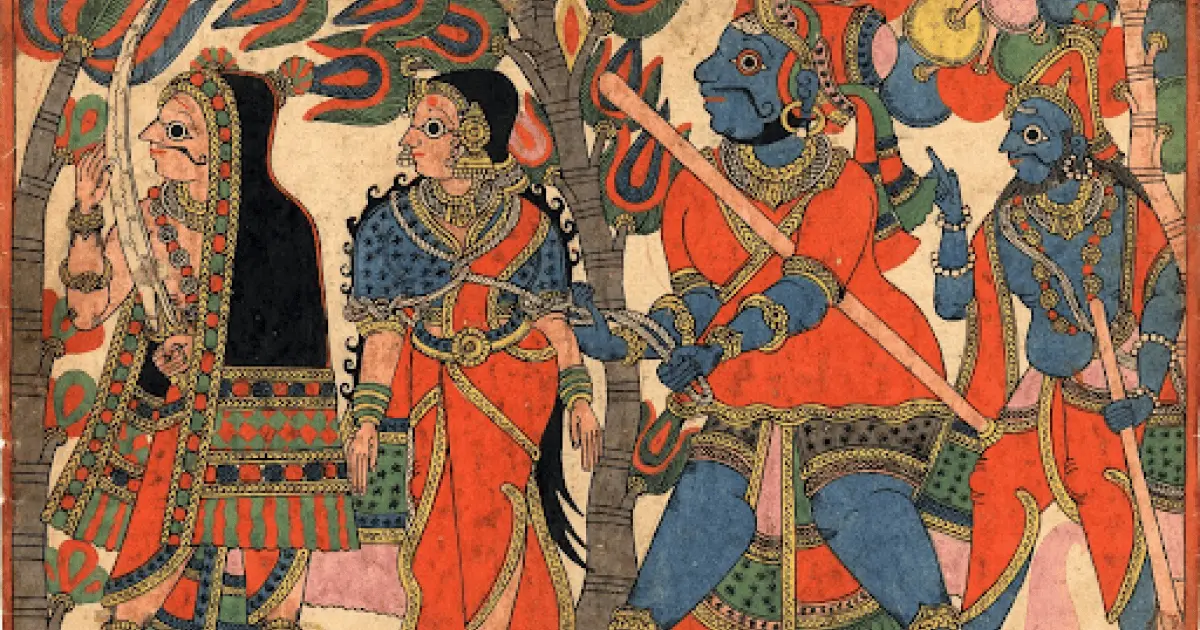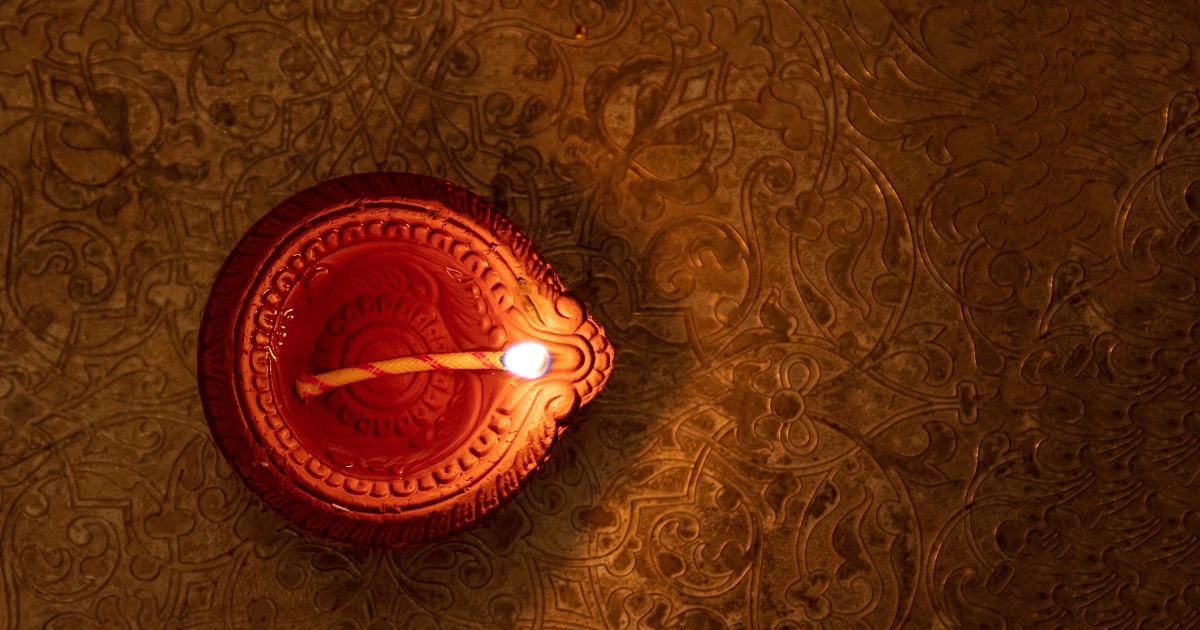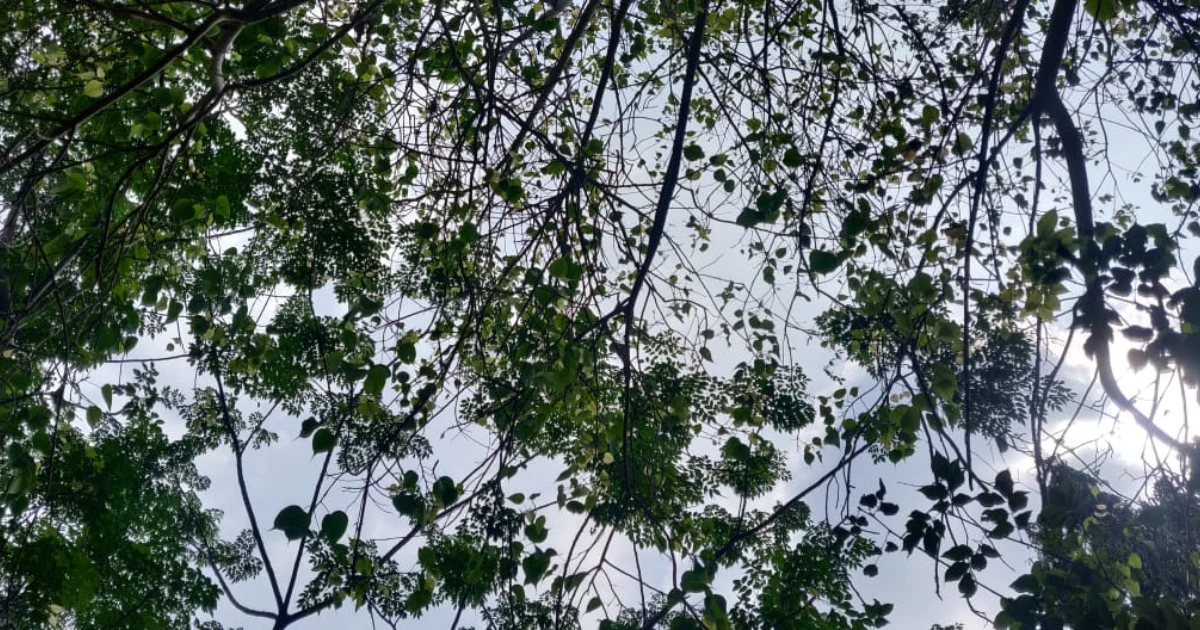Introduction
Paiṭhaṇ paintings come from a flourishing tradition of narrative illustrations and are the work of the village artists from the Mahārāṣṭra-Karṇāṭaka border region belonging to the Citrakathi caste, the earliest ones traced to the town of Paithan near Aurangabad.1 They are known for their bold and striking stylistic visual representation of tales from the purāṇas and itihāsa, redolent of the shadow puppetry traditions of Karnataka and Andhra Pradesh. The primary purpose of Paiṭhaṇ paintings, referred to as Citrakathas or picture-stories, was their use as visual aids in bardic recitals and story-telling by the Citrakathi caste, who would perform at village fairs, during festivals such as Navarātri and Gaṇeś Caturthi, and at other large gatherings. This particular painting (represented in figure 1) is part of a complete set (pothi, or *a loose-leaf folio) of sixty paintings, currently housed at the British Museum, London, which depicts the story of King Hariścandra, one of the most popular stories told and retold across the length and breadth of India. The source of the story referred to is primarily the text of the *Mahābhārata, but is elaborated in in the Mārkaṇḍeya Purāṇa, although it also finds retellings in other purāṇas such as the Devi Bhāgavata. Multiple variations of the tale exist in a number of regional languages. However, there is reason to believe that the Citrakathis appear to have relied on the Marāṭhi version of the tale.2 King Hariścandra, or ‘Satya’ Hariścandra, as he is so called — the protagonist of this tale — is known for his unflinching adherence to the truth, *dharma *and his word, and his character is tested by the sage Viśvāmitra who puts him through the most brutal of trials and hardships.
Paiṭhāṇ paintings have an audacious and striking visual impact. Vibrant pigments, and boldly drawn human figures form the primary focus of the narrative vision. The faces in a typical Paiṭhaṇ painting appear stoic, however, the detail and the relative size and stance of the characters conveys the intended melodrama. This particular composition (figure 1) measures about 29 cm by 40 cm, and portrays one of the important scenes leading up to the climactic point in the story. On the extreme left is Hariścandra, reduced to the status of being a slave to a caṇḍāla, who is, in actuality, Yamadharmarāja in disguise. Hariścandra is dressed in a dhotī and shrouded in a dark black uttarīya or cape, alluding to his role as an executioner, and holds an imposing curved sword while leading Tārāmati to her impending death. Queen Tārāmati’s shoulders and arms are bound by rope in an ornate winding pattern, and she is dressed in a sāri, with her rich black hair cascading down her back, richly adorned in jewellery — although in the story, she had lost her entire kingdom and had been enslaved, impoverished, and devastated by her son’s death. Tārāmati is followed by the caṇḍāla, who wears a jāmā (a long-sleeved shirt), and the figure seen on the far right is Viṡvāmitra, whose presence was simply to keep a close watch on the actions of Hariścandra. Anna Dallapiccola describes the style of the paintings as having
“a certain monumentality reminiscent of wall paintings”,3 while Eva Ray, in a similar vein, states that the style is best described as “muralistic”, where “the broad and clear forms vividly delineate the narrative scenes”.4 The narrative purpose of these works is served exceedingly well by the monoscenic imagery. With the depiction of each episode in the tale arrested in the mind of the viewer, the narrator is then enabled to fill in the details and elaborate the scene depicted in each folio through song or recitation accompanied by a rhythm provided by musical instruments.
Figure 2. Paiṭhaṇī story-telling painting, illustrating the story of Satya Hariścandra from the Mahābhārata. Hariścandra is poised to decapitate the queen, as the Gods watch from above. Paithan Style, opaque watercolor on paper, late 19th – 20th century, British Museum
Another painting from the same pothi (bundle) that illustrates the narrative effectiveness of these paintings is the one that depicts the climactic scene in the story, when Tārāmati is about to be decapitated by Hariścandra, seen in fig. 2. In the lower half of the painting, Hariścandra raises his sword and is on the verge of executing the queen, who stands demurely before him, her hands folded. In the panel above, the gods — Śiva wearing a rudrākṣamāla, seated with a yogapaṭṭa, with his hair in a coiled jaṭa; Viṣṇu holding a śankha and a cakra; the four-headed Brahma holding a scroll; and the Sage Vaṣiṣṭha, an advocate for Hariścandra, watch the queen's impending execution and contemplate an intervention. A decorative border divides both the worlds, similar to the manner in which horizontal compositions are often partitioned into two through the use of a vertical element5. Paiṭhāṇ paintings are almost always horizontally aligned, with few exceptions. This is the only page in this particular pothī which is vertically arranged. The change of format is due to the dramatic nature of the scene being depicted: it brings the viewer’s attention to the fact that the gods are watching the story as it plays out in the cremation ground. Hariścandra and Tāramati, on the other hand, despite the morose gravitas of the situation, are portrayed as if at the culmination of a marriage ceremony.
The Citrakathis
Citrakathi, meaning ‘those that tell stories through pictures’, or “picture showmen”, is a specialized jāti of artisans from Mahārāṣṭra. The Citrakathi community is scattered across the region in pockets, as described in multiple accounts compiled by colonial anthropologists and surveyors. However, many of the families described have either moved out of this occupation or their lineage has unfortunately tapered off. At present, it is surmised that only a small group of Citrakathis who are still engaged in their hereditary occupation remain. Eva Ray documents that “the Thakars who live in the Gudewadi section of Pinguli village (in the former princely state of Sawantwadi) in Mahārāṣṭra are known to present picture shows to this day. They claim that the pictures in their possession were painted by their ancestors. The Thakars have also in their collection leather puppets and wooden dolls, which are likewise exhibited along with narration.”5A similarity between the styles of pothis produced at different locations reveals a correlation between the artists and *Citrakathi *families in various regions. Dallapiccola postulates that in all probability, “every family has its own style which evolved in the course of time depending on the ability or otherwise of the individual.”6 The similarity in style and approach, in turn, can be attributed to the hereditary transmission of the knowledge of the stylistic elements and the technique of painting.
Valentina Stache-Rosen, in her posthumous work detailing the Citrakathis of Pinguli, situated in the Ratnagiri district of South Western Mahārāṣtra, describes a typical performance7:
A Chitrakathi's performance is accompanied by a huduk (a kind of drum), a three-stringed tambura, and cymbals, called jhinj. The performer squats on the ground and places a wooden board the size of the pothi *against his knees as a support for the pictures; a piece of cloth prevents them from slipping. Sometimes the *pothi will be placed on the ground near the performer, and the pictures will be taken up one by one as the story progresses. In other instances, the performer puts up the whole pothi against the wooden board and flings the pictures aside when he has finished with them. .. Every performance begins by showing a picture of Ganpati and that of Sarasvati on the reverse, but not every pothi has these pictures. These deities will be praised in a song before the actual performance starts. No special pujas are performed in the houses for the pothis, but during Navaratri the pujāri performs pūjā with arati, coconuts, flowers, red powder, and incense.
Figure 4. Paiṭhaṇī story-telling painting depicting Goddess Sarasvati. The Goddess is seated on a raised and decorated platform. Facing her is her vāhana, the swan, which is stylised such that its plumage resembles that of a peacock. She holds a manuscript, symbolizing knowledge, a pair of cymbals, and a vīṇa. Her vāhana, towers over the goddess, and is magnificently bejewelled, with a foliated and colourful tail and majestic talons. Paithan Style, opaque watercolour on paper, late 19th – 20th century, British Museum.
The Landscape of Narrative and Storytelling Traditions
A host of regional bardic and storytelling traditions exist across India, each of great antiquity, each having its own kathā exposition style and employing a multitude of creative visual aids, such as puppets, images, costume, wooden dolls, etc. Stories from Sanskrit texts such as episodes from the purāṇas and itihāsa were disseminated widely among the masses in creative and compelling ways, as plays, bardic recitations, puppet shows, folk songs, and rich and varied traditions of storytelling.
Though the hereditary profession has all but died out, the remarkable achievements of the Citrakathis, both artistically and as narrativists, have lived on. Anna Dallapiccola remarks that the “visual language evolved by the Chitrakathis is most refined, revealing an astonishing degree of psychological insight. Highly imaginative and very concise, the visual idiom is based on a set of formulae common to all painters and rigorously applied in the rendering of human figures, architectural elements, as well as in the arrangement of the landscape. The evolution of such highly sophisticated language was possible in a milieu in which artists and audience shared the same cultural background.”8
Conclusion
The* Citrakathis* and their painting and narrative traditions are but one of the many fine instances of the phenomenology of a complex visual culture that evolved over millennia and migrated, transmogrified, and manifested in diverse fashions. Given the inveterate Indian tradition of storytelling, the typology of traditions that have been lost due to the advent of successive colonisations and subsequently, modernization, are undoubtedly
Significant. Nevertheless, the corpus of knowledge that remains is indicative of the richness of the landscape of Indian narratology.9
Endnotes and References
1 Ray, Eva. “Documentation for Paiṭhān Paintings.” Artibus Asiae 40, no. 4 (1978): p. 239 https://doi.org/10.2307/3249820.
2 Ibid., p. 280
3 Dallapiccola , Anna L. “''Paithan'' Paintings: The Epic World of the Chitrakathis.” Essay. In Jain, Jyotindra*, ed., *Picture Showmen: Insights into the Narrative Tradition in Indian Art Vol. 49, 3rd ed., p. 68. Mumbai: Marg Publications, 1998. \
4 Ray, Eva. “Documentation for Paiṭhān Paintings.” Artibus Asiae 40, no. 4 (1978): p. 241. https://doi.org/10.2307/3249820. Accessed 06 Feb. 2023.
5 Ray, Eva. “Documentation for Paiṭhān Paintings.” Artibus Asiae 40, no. 4 (1978): 240. https://doi.org/10.2307/3249820.
6 ''Paithan'' Paintings: The Epic World of the Chitrakathis. Anna L. Dallapiccola in Picture Showmen: Insights Into the Narrative Tradition in Indian Art. India: Marg Publications, 1998. p. 71
7 Stache-Rosen, Valentina. “Story-Telling in Pingulī Paintings.” Artibus Asiae 45, no. 4 (1984): p. 255. https://doi.org/10.2307/3249740.
8 ''Paithan'' Paintings: The Epic World of the Chitrakathis. Anna L. Dallapiccola in Picture Showmen: Insights Into the Narrative Tradition in Indian Art. India: Marg Publications, 1998. p. 70
9 Indian Narratology. K. Ayyappa Paniker; Indira Gandhi National Centre for the Arts, 2003. p. 1
Jain, Jyotindra, ed. Picture Showmen: Insights into the Narrative Tradition in Indian Art. Vol. 49, 3rd ed., Marg Publications* *for the National Centre for the Performing Arts, Mumbai, 1998.
K. Ayyappa Paniker,* Indian Narratology. Indira Gandhi National Centre for Arts in association with Sterling Publishers Private Limited, New Delhi, 2003 *.
Ray, Eva. “Documentation for Paiṭhān Paintings.” Artibus Asiae 40, no. 4 (1978): 239–82. https://doi.org/10.2307/3249820. Accessed 06 Feb. 2023.
Stache-Rosen, Valentina. “Story-Telling in Pingulī Paintings.” Artibus Asiae 45, no. 4 (1984): 253–86. https://doi.org/10.2307/3249740. Accessed 28 Mar. 2023.







